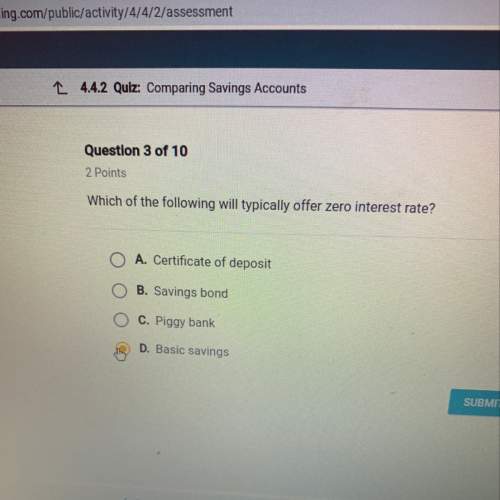
In performing activity analysis during the design of an activity-based costing (ABC) system, the management accountant studies:
a. The implementation problems for an ABC system.
b. The advice of operation-level managers.
c. The cost drivers and managers in the plant.
d. The resources, activities, and cost drivers in the operation.
e. The cost allocation methods applicable to the firm.

Answers: 1


Another question on Business

Business, 21.06.2019 23:00
Which of the following statements about the relationship between economic costs and accounting costs is true? multiple choice accounting costs are equal to or greater than economic costs. accounting costs must always equal economic costs. accounting costs are always greater than economic costs. accounting costs are always less than or equal to economic costs.
Answers: 2

Business, 22.06.2019 19:50
Juan's investment portfolio was valued at $125,640 at the beginning of the year. during the year, juan received $603 in interest income and $298 in dividend income. juan also sold shares of stock and realized $1,459 in capital gains. juan's portfolio is valued at $142,608 at the end of the year. all income and realized gains were reinvested. no funds were contributed or withdrawn during the year. what is the amount of income juan must declare this year for income tax purposes?
Answers: 1

Business, 22.06.2019 21:30
Zara, a global retail and apparel manufacturer based in spain that has successfully implemented this idea by having a continuous flow of new products that are typically limited in supply. zara has created a system that draws its clientèle into its stores, on average, 17 times per year as compared to 4 times per year for most stores. how is zara using it to gain competitive advantage? what specific technologies are used by zara to maintain this advantage over its competition?
Answers: 3

Business, 23.06.2019 17:00
5. understanding marginal and average tax rates consider the economy of citronia, where citizens consume only oranges. assume that oranges are priced at $1 each. the government has devised the following tax plans: plan a • consumption up to 1,000 oranges is taxed at 50%. • consumption higher than 1,000 oranges is taxed at 20%. plan b • consumption up to 2,000 oranges is taxed at 15%. • consumption higher than 2,000 oranges is taxed at 60%. use the plan a and plan b tax schemes to complete the following table by deriving the marginal and average tax rates under each tax plan at the consumption levels of 300 oranges, 1,200 oranges, and 3,000 oranges, respectively. consumption level plan a plan b (quantity of oranges) marginal tax rate average tax rate marginal tax rate average tax rate (percent) (percent) (percent) (percent) 300 1,200 3,000 complete the following table by indicating whether each plan is a progressive tax system, a proportional tax system, or a regressive tax system. progressive proportional regressive plan a plan b
Answers: 2
You know the right answer?
In performing activity analysis during the design of an activity-based costing (ABC) system, the man...
Questions

Mathematics, 22.10.2020 19:01

English, 22.10.2020 19:01


Mathematics, 22.10.2020 19:01


Computers and Technology, 22.10.2020 19:01




Mathematics, 22.10.2020 19:01

Mathematics, 22.10.2020 19:01

Mathematics, 22.10.2020 19:01




Mathematics, 22.10.2020 19:01







